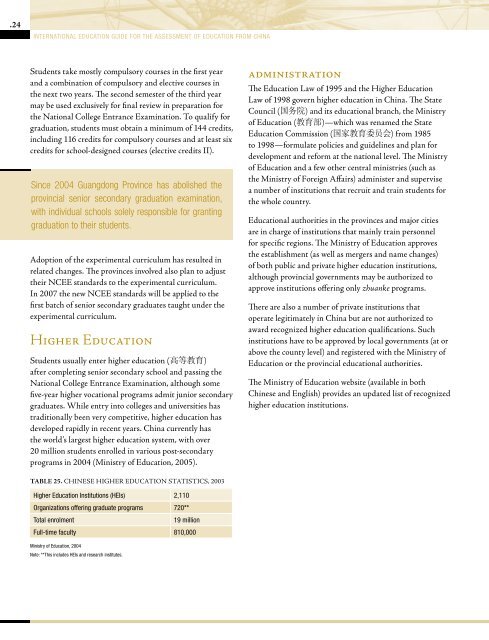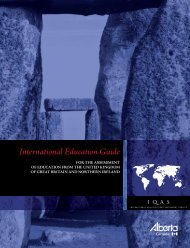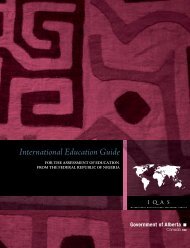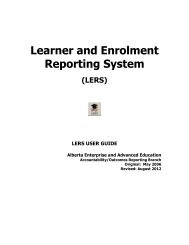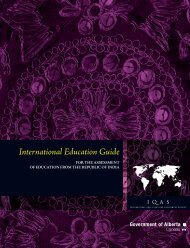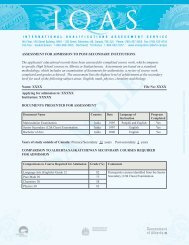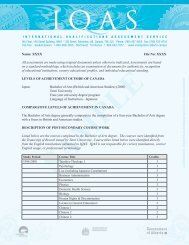International Education Guide - China - Enterprise and Advanced ...
International Education Guide - China - Enterprise and Advanced ...
International Education Guide - China - Enterprise and Advanced ...
You also want an ePaper? Increase the reach of your titles
YUMPU automatically turns print PDFs into web optimized ePapers that Google loves.
.24<br />
INTERNATIONAL EDUCATION GUIDE FOR THE ASSESSMENT OF EDUCATION FROM CHINA<br />
Students take mostly compulsory courses in the first year<br />
<strong>and</strong> a combination of compulsory <strong>and</strong> elective courses in<br />
the next two years. The second semester of the third year<br />
may be used exclusively for final review in preparation for<br />
the National College Entrance Examination. To qualify for<br />
graduation, students must obtain a minimum of 144 credits,<br />
including 116 credits for compulsory courses <strong>and</strong> at least six<br />
credits for school-designed courses (elective credits II).<br />
Since 2004 Guangdong Province has abolished the<br />
provincial senior secondary graduation examination,<br />
with individual schools solely responsible for granting<br />
graduation to their students.<br />
Adoption of the experimental curriculum has resulted in<br />
related changes. The provinces involved also plan to adjust<br />
their NCEE st<strong>and</strong>ards to the experimental curriculum.<br />
In 2007 the new NCEE st<strong>and</strong>ards will be applied to the<br />
first batch of senior secondary graduates taught under the<br />
experimental curriculum.<br />
Higher <strong>Education</strong><br />
Students usually enter higher education ( 高 等 教 育 )<br />
after completing senior secondary school <strong>and</strong> passing the<br />
National College Entrance Examination, although some<br />
five-year higher vocational programs admit junior secondary<br />
graduates. While entry into colleges <strong>and</strong> universities has<br />
traditionally been very competitive, higher education has<br />
developed rapidly in recent years. <strong>China</strong> currently has<br />
the world’s largest higher education system, with over<br />
20 million students enrolled in various post-secondary<br />
programs in 2004 (Ministry of <strong>Education</strong>, 2005).<br />
administration<br />
The <strong>Education</strong> Law of 1995 <strong>and</strong> the Higher <strong>Education</strong><br />
Law of 1998 govern higher education in <strong>China</strong>. The State<br />
Council ( 国 务 院 ) <strong>and</strong> its educational branch, the Ministry<br />
of <strong>Education</strong> ( 教 育 部 )—which was renamed the State<br />
<strong>Education</strong> Commission ( 国 家 教 育 委 员 会 ) from 1985<br />
to 1998—formulate policies <strong>and</strong> guidelines <strong>and</strong> plan for<br />
development <strong>and</strong> reform at the national level. The Ministry<br />
of <strong>Education</strong> <strong>and</strong> a few other central ministries (such as<br />
the Ministry of Foreign Affairs) administer <strong>and</strong> supervise<br />
a number of institutions that recruit <strong>and</strong> train students for<br />
the whole country.<br />
<strong>Education</strong>al authorities in the provinces <strong>and</strong> major cities<br />
are in charge of institutions that mainly train personnel<br />
for specific regions. The Ministry of <strong>Education</strong> approves<br />
the establishment (as well as mergers <strong>and</strong> name changes)<br />
of both public <strong>and</strong> private higher education institutions,<br />
although provincial governments may be authorized to<br />
approve institutions offering only zhuanke programs.<br />
There are also a number of private institutions that<br />
operate legitimately in <strong>China</strong> but are not authorized to<br />
award recognized higher education qualifications. Such<br />
institutions have to be approved by local governments (at or<br />
above the county level) <strong>and</strong> registered with the Ministry of<br />
<strong>Education</strong> or the provincial educational authorities.<br />
The Ministry of <strong>Education</strong> website (available in both<br />
Chinese <strong>and</strong> English) provides an updated list of recognized<br />
higher education institutions.<br />
Table 25. Chinese Higher <strong>Education</strong> Statistics, 2003<br />
Higher <strong>Education</strong> Institutions (HEIs) 2,110<br />
Organizations offering graduate programs 720**<br />
Total enrolment<br />
19 million<br />
Full-time faculty 810,000<br />
Ministry of <strong>Education</strong>, 2004<br />
Note: **This includes HEIs <strong>and</strong> research institutes.


